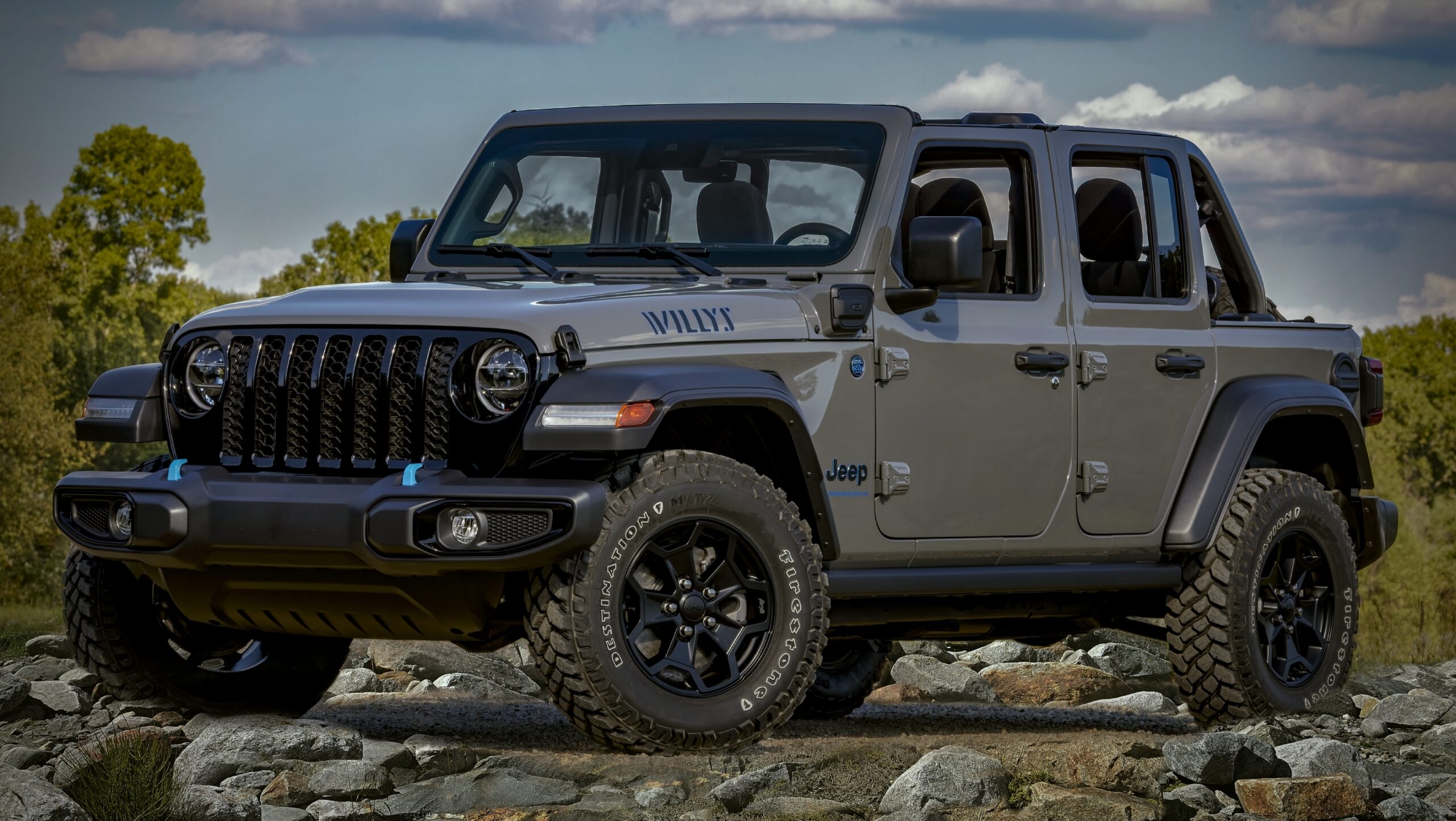Jeep Tractor For Sale: Your Comprehensive Guide to a Versatile Workhorse
Jeep Tractor For Sale: Your Comprehensive Guide to a Versatile Workhorse jeeps.truckstrend.com
Introduction: Unearthing the Enduring Appeal of the Jeep Tractor
In the world of agricultural and utility vehicles, the term "tractor" often conjures images of large, purpose-built machines. However, a unique and highly versatile workhorse has quietly carved out its own niche: the Jeep Tractor. Far from a conventional farm implement, a Jeep Tractor is typically a classic Willys Jeep (or similar early civilian Jeep model) that has been ingeniously modified for farm, garden, or general utility work. These rugged machines combine the legendary durability and four-wheel-drive capability of the Jeep chassis with the functionality of a tractor, often featuring a power take-off (PTO), a three-point hitch, and various hydraulic systems to operate implements.
Jeep Tractor For Sale: Your Comprehensive Guide to a Versatile Workhorse
Born out of post-World War II ingenuity and the abundance of surplus military Jeeps, these conversions offered farmers and landowners an affordable, compact, and incredibly robust alternative to traditional tractors. Today, the appeal of a Jeep Tractor remains strong, particularly for those seeking a cost-effective, easily maintainable, and remarkably versatile machine for small farms, homesteads, logging operations, or even just extensive property management. If you’re considering adding one of these unique vehicles to your arsenal, understanding their history, benefits, and the intricacies of buying one is crucial. This comprehensive guide will equip you with all the knowledge you need to navigate the world of Jeep Tractors for sale.
What Exactly is a Jeep Tractor? A Legacy of Ingenuity
At its heart, a Jeep Tractor is a testament to American resourcefulness. Following WWII, thousands of surplus Willys MB and Ford GPW Jeeps became available. Their robust frames, reliable engines, and excellent traction made them ideal candidates for repurposing beyond their military origins. Civilians quickly realized the potential for these vehicles to replace draft animals or less capable farm equipment.
The transformation typically involved several key modifications:
- Power Take-Off (PTO): A critical addition, allowing the Jeep’s engine power to be redirected to operate external implements like mowers, tillers, or pumps. Many early Jeeps, particularly the Willys CJ-2A and CJ-3A, were even factory-equipped with PTO options or designed to easily accept them.
- Three-Point Hitch: While less common as a factory option, many conversions added a three-point hitch system (either Category 0 or 1) to attach plows, cultivators, disc harrows, and other ground-engaging tools.
- Hydraulic Systems: To operate the three-point hitch or other hydraulic implements, an independent hydraulic pump and reservoir were often installed.
- Specialized Gearing/Low Range: The Jeep’s existing transfer case often provided sufficient low-range gearing for slow, powerful work, but some conversions might have added auxiliary transmissions or modified axle ratios for even greater torque at low speeds.
- Heavy-Duty Tires: Agricultural-style tires or aggressive off-road tires were often fitted for maximum traction in varied terrain.

The most common base models for these conversions include the Willys CJ-2A, CJ-3A, CJ-3B, and later CJ-5, due to their simple mechanics, robust build, and widespread availability of parts. Companies like Monroe Auto Equipment also produced specific "Jeep-A-Trench" or "Jeep-A-Loader" attachments, further blurring the lines between a traditional Jeep and a dedicated piece of farm machinery.
Benefits of Owning a Jeep Tractor: More Than Just Nostalgia
The enduring popularity of Jeep Tractors isn’t just about their historical charm; it’s rooted in their practical advantages:
- Cost-Effectiveness: Compared to a new compact utility tractor, a used Jeep Tractor can be significantly more affordable to purchase, making it an excellent entry point for small-scale operations or those on a tighter budget.
- Exceptional Versatility: Beyond traditional farm tasks like plowing, tilling, and hauling, a Jeep Tractor can be used for logging, snow removal, operating post-hole diggers, running generators, or simply as a robust utility vehicle for property maintenance.
- Legendary Durability and Repairability: Jeeps of this era were built to be simple, tough, and easily repairable in the field. Their mechanical systems are straightforward, and parts for many classic Willys models are still widely available and relatively inexpensive. This translates to lower maintenance costs and the ability for owner-operators to perform most repairs themselves.
- Compact Size and Maneuverability: Their relatively small footprint allows them to navigate tight spaces, wooded areas, and smaller fields where larger tractors might struggle.
- Four-Wheel Drive Capability: Unlike many two-wheel-drive farm tractors, the Jeep Tractor’s 4×4 system provides superior traction in muddy conditions, on hills, or when pulling heavy loads.
- DIY Satisfaction: For those who enjoy working on their own equipment, owning a Jeep Tractor offers a rewarding hands-on experience, from minor repairs to potential further modifications.
![]()
Key Considerations Before Buying: Due Diligence is Paramount
Acquiring a Jeep Tractor requires careful consideration, as many are vintage vehicles with varying degrees of modification and wear.
- Define Your Purpose: What specific tasks will the Jeep Tractor primarily perform? This will dictate the necessary features (e.g., PTO, 3-point hitch, hydraulic capacity) and the condition required.
- Condition of the Base Vehicle:
- Engine: Check for leaks, excessive smoke (especially blue or black), strange noises, and difficulty starting. A compression test can reveal engine health.
- Drivetrain: Inspect the transmission, transfer case, and axles for leaks, grinding noises, and proper engagement of gears and 4WD.
- Frame and Body: Rust is the ultimate enemy. Pay close attention to the frame rails, spring perches, body mounts, and floorboards. Look for cracks or shoddy repairs.
- Steering and Brakes: Ensure they are functional and free of excessive play.
- Quality of Modifications: How well was the conversion done? Are the PTO, hitch, and hydraulics professionally installed and robust? Look for clean welds, proper plumbing, and secure mounting.
- Parts Availability: While many Willys Jeep parts are available, highly customized or obscure PTO units might be harder to source if they break. Research the specific model’s parts commonality.
- Legalities: Most Jeep Tractors are not road legal in their converted state. Understand local regulations regarding farm equipment registration, especially if you plan to move it between properties.
- Budget Beyond Purchase Price: Factor in potential repair costs, transportation, and the cost of any implements you’ll need.
Where to Find Jeep Tractors for Sale: Hunting for Your Workhorse
The market for Jeep Tractors is diverse and often requires a bit of detective work.
- Online Classifieds & Marketplaces:
- Craigslist and Facebook Marketplace: Excellent sources for local listings. Use keywords like "Jeep tractor," "Willys PTO," "farm Jeep," or "Jeep utility vehicle."
- eBay: Can have a wider geographical reach, sometimes offering unique or well-preserved examples.
- Specialized Forums & Groups: Online communities dedicated to vintage Jeeps, Willys vehicles, or antique farm equipment often have "for sale" sections. These are great places to find knowledgeable sellers and well-documented builds.
- Farm Equipment Auctions: Local farm auctions, especially in rural areas, can occasionally feature a Jeep Tractor among other implements.
- Local Classifieds & Word-of-Mouth: Sometimes the best deals are found through traditional newspaper ads or by simply asking around in farming communities.
- Estate Sales: When older properties are sold, unique vehicles like Jeep Tractors might surface.
Inspecting a Jeep Tractor: A Buyer’s Checklist
A thorough inspection is non-negotiable. If you’re not mechanically inclined, bring someone who is.
- Initial Walk-Around: Check overall appearance, signs of neglect, fluid leaks, and tire condition. Look for mismatched tires or excessive wear.
- Frame & Undercarriage: Get underneath if possible. Check for rust, cracks, patched areas, and bent components. Pay attention to spring mounts, shackle bushings, and steering components.
- Engine:
- Cold Start: Listen for knocking, excessive smoke, or difficulty starting.
- Running: Check for smooth idle, proper oil pressure (if gauge works), and unusual noises. Look for leaks (oil, coolant, fuel).
- Exhaust: Blue smoke indicates oil burning; black indicates rich fuel mix; white could be coolant.
- Drivetrain:
- Transmission: Test all gears, forward and reverse. Listen for grinding or popping out of gear.
- Transfer Case: Engage 2WD, 4-High, and 4-Low. Ensure all engage smoothly without excessive clunking.
- Axles: Check for leaks at the differential covers and axle seals.
- PTO: If equipped, ensure it engages and disengages smoothly. Listen for unusual noises. If possible, test it with an implement or watch it spin.
- Hydraulics (if present): Check the fluid level and condition. Look for leaks in hoses, pumps, and cylinders. Test the lift and lower functions of the 3-point hitch.
- Electrical System: Test lights, gauges, horn, and wipers (if present). Check battery condition and wiring for signs of rodent damage or poor connections.
- Brakes & Steering: Test brakes for effectiveness and pulling. Check steering for excessive play and smooth operation.
- Safety: Note any missing safety guards, sharp edges, or precarious modifications. ROPS (Roll-Over Protection Structure) is rarely present but highly recommended for tractor use.
Understanding Pricing: Factors Influencing Value
The price of a Jeep Tractor can vary wildly, from a few hundred dollars for a non-running project to several thousand for a fully restored, turn-key machine with implements.
- Overall Condition: The biggest factor. A running, working Jeep Tractor will command a higher price than a rust bucket needing a full restoration.
- Original Jeep Model: Some models (e.g., early CJ-2As with specific features) might be more desirable.
- Quality of Conversion: A professionally done, robust conversion adds value. A shoddy, unsafe DIY job detracts from it.
- Included Implements: If it comes with a functional plow, disc, tiller, or other valuable attachments, the overall package price will be higher.
- Location: Demand and availability can influence prices regionally.
- Rarity/Collectibility: While most are workhorses, some exceptionally preserved or unique conversions might attract collectors.
Maintaining Your Jeep Tractor: Keeping It Running for Decades
Once you own a Jeep Tractor, regular maintenance is key to its longevity and reliability.
- Regular Fluid Changes: Engine oil, transmission fluid, transfer case fluid, and differential fluid should be changed according to the original Jeep service manual’s recommendations or more frequently for heavy use.
- Greasing: Regularly grease all zerks on the chassis, steering components, and PTO shafts.
- Tire Pressure: Maintain correct tire pressure for stability and traction.
- Inspections: Routinely check for loose bolts, worn belts, frayed hoses, and electrical issues.
- Rust Prevention: Address any new rust spots promptly to prevent further deterioration of the frame and body.
- Tune-Ups: Keep the engine tuned with fresh spark plugs, points (if applicable), and filters.
- Safety Checks: Always ensure all safety mechanisms are functional before operation.
Price Table: Estimating Jeep Tractor Values
Please note: These prices are highly generalized estimates and can fluctuate significantly based on condition, location, specific modifications, and market demand. Always inspect thoroughly and negotiate.
| Condition Category | Estimated Price Range (USD) | Description |
|---|---|---|
| Project/As-Is | $500 – $2,500 | Non-running, significant rust, major mechanical issues, potentially incomplete. Requires extensive restoration or parts. Often sold as-is for salvage or ambitious DIY projects. |
| Running/Needs TLC | $2,500 – $6,000 | Runs and drives but has obvious mechanical issues (leaks, noisy drivetrain), cosmetic flaws, or non-functional PTO/hydraulics. Usable with immediate repairs, but not turn-key. Good for someone with mechanical skills. |
| Good Condition | $6,000 – $12,000 | Starts easily, runs well, all major systems (engine, transmission, 4WD, PTO, hydraulics) are functional. Minor leaks or cosmetic imperfections. Ready for immediate work, may include basic implements. Good value for regular use. |
| Restored/Turn-Key | $12,000 – $25,000+ | Professionally restored or exceptionally well-maintained. Excellent mechanical and cosmetic condition. All systems fully functional. Often includes a set of implements. Suitable for heavy use, show, or collector. |
Note: Prices can vary widely. Always factor in potential repair, transport, and implement costs.
Frequently Asked Questions (FAQ) About Jeep Tractors
Q1: Is a Jeep Tractor road legal?
A1: Generally, no. Most Jeep Tractors are modified in a way that makes them unsafe or illegal for public road use (e.g., lack of proper lighting, turn signals, or speed limitations). They are typically designed for off-road farm or utility work. Check your local regulations for farm equipment registration and movement.
Q2: What’s the best Jeep model for a conversion or to buy as a tractor?
A2: The Willys CJ-2A and CJ-3A are historically the most common and arguably the "best" base models due to their simplicity, robust frame, and design that easily accommodated PTO units. The CJ-3B and CJ-5 were also used. Avoid later, more complex Jeep models with independent suspension or extensive electronics.
Q3: Can I attach modern implements to a Jeep Tractor?
A3: It depends on the hitch system. Many Jeep Tractors feature a Category 0 or Category 1 three-point hitch, which can accept a wide range of compatible implements. However, the Jeep’s horsepower and hydraulic capacity may limit the size and type of implements it can effectively operate compared to a modern tractor. Always check specifications.
Q4: Are parts for Jeep Tractors hard to find?
A4: Parts for the base Willys Jeep models (engine, drivetrain, chassis components) are surprisingly abundant from specialty suppliers and online retailers. However, parts for specific, older PTO units or hydraulic systems might be more challenging to source and may require fabrication or adaptation.
Q5: Is a Jeep Tractor safe to operate?
A5: Like any piece of heavy machinery, a Jeep Tractor can be dangerous if not operated properly. They often lack modern safety features like ROPS (Roll-Over Protection Structure) or seatbelts. Always operate with extreme caution, understand its limitations, avoid steep slopes, and never allow passengers. Prioritize safety modifications if possible.
Q6: What’s the typical lifespan of a well-maintained Jeep Tractor?
A6: With proper maintenance and care, a Jeep Tractor can last for decades, often outliving many newer, more complex machines. Their simple, robust design means that components can be repaired or replaced indefinitely, making them a truly long-term investment.
Concluding Summary: A Rewarding Investment for the Right Owner
The Jeep Tractor stands as a unique testament to American ingenuity, durability, and versatility. For those with a need for a robust, cost-effective, and easily maintainable workhorse for their property, a Jeep Tractor can be an immensely rewarding investment. Whether you’re managing a small farm, maintaining a large acreage, or simply seeking a piece of functional history, these machines offer unparalleled value.
However, the journey to finding and owning the right Jeep Tractor requires diligence. Thorough research, careful inspection, and a realistic understanding of potential maintenance are key to a successful purchase. By embracing their vintage charm and appreciating their inherent capabilities, you’ll find that a Jeep Tractor is far more than just a vehicle for sale; it’s a piece of living history ready to tackle the tasks of tomorrow.





